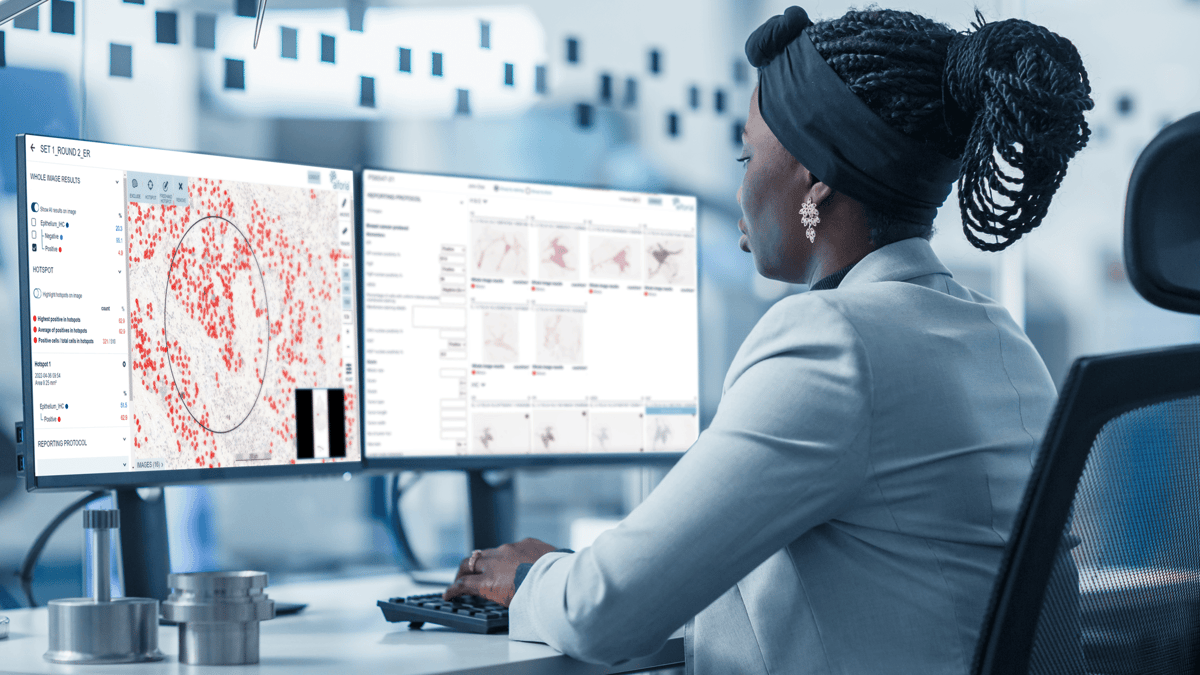Challenges in breast cancer diagnostics
In 2022, breast cancer was the second-highest cancer type in the number of incidents, right after lung cancer.1 In the next 20 years (2025-2045), WHO’s International Agency for Research estimates that the number of new breast cancer cases will increase from 2.3 million to 2.94 million worldwide.2 This has and will continue to place a significant burden on pathologists, an already underrepresented group of healthcare professionals. Meanwhile, the tools currently available to pathologists do not reflect the ever-rising demand of their field.
Pathologists devote much of their time to analyzing slides—a task that is detailed and highly manual. Because this work is intensive, and labs face rising case volumes alongside a shortage of pathologists, patients may experience delays in receiving results and therefore treatment decisions. Reliable, efficient clinical tools can support pathologists and help patients receive timely, consistent care.
The current methods used for breast cancer grading and biomarker scoring are particularly prone to variability. For example, commonly used scoring schemes necessitate pathologists to extract quantitative parameters subject to inter- and intraobserver variability. The need for objective and standardized tools is evident. Deep learning artificial intelligence (AI) was intended to perform these repetitive quantification tasks, wholly immune to bias and variability. Analyses with AI can be replicated consistently, no matter the sample type, size, or any other human condition impairing its performance.
AI-assisted data and decision support
AI can help pathologists and patients overcome these issues. By automating time-consuming manual tasks, AI can count cells and biomarkers or identify tissue areas in a fraction of the time humans can, allowing pathologists to deliver timely and accurate prognoses.
In addition to its clinical benefits, AI can help reduce costs and balance workload distribution. Reducing diagnostic error and misdiagnosis while improving treatment accuracy with more detailed results will provide direct cost savings due to greater precision. With fewer manual, repetitive, and time-consuming tasks, pathologists can focus their time and energy on rare or complex cases requiring more analysis expertise.
Read more about the benefits of using AI in clinical diagnostics: 5 reasons to use AI in clinical diagnostics

Breast cancer diagnostics tools: Aiforia’s CE-IVD marked AI solutions
Aiforia® Breast Cancer Suite offers a fully digital cockpit for breast cancer diagnostics, supporting the entire diagnostic workflow. It includes six CE-IVD marked clinical AI solutions for breast cancer: Grading, ER, PR, HER2, Ki67, and Lymph Node Metastasis. These solutions have the potential to improve the prognostic and predictive value of breast cancer diagnostics, helping pathologists to analyze medical images in a timely and consistent manner.
- Aiforia® Breast Cancer Grading automates breast cancer grading from H&E-stained whole-slide images (WSI), accurately identifying invasive carcinoma and ductal carcinoma in situ (DCIS). It objectively scores mitotic count, tubular formation, and nuclear pleomorphism, addressing key challenges of manual grading such as variability and time constraints, consistent with the Nottingham Grading System.
- Aiforia® Breast Cancer ER automatically detects invasive carcinoma and quantifies ER-positive and negative tumor cells from whole-slide images (WSI) or selected tissue areas, supporting consistent and objective scoring.
- Aiforia® Breast Cancer PR automatically detects invasive carcinoma and quantifies PR-positive and negative cells from whole-slide images (WSI) or selected tissue regions, enhancing diagnostic clarity and workflow.
- Aiforia® Breast Cancer HER2 accurately identifies invasive carcinoma and scores HER2 expression in alignment with CAP guidelines, improving diagnostic reliability and workflow efficiency.
- Aiforia® Breast Cancer Ki67 automatically detects invasive carcinoma and quantifies Ki67-positive and negative tumor cells from whole-slide images (WSI) or targeted image regions, improving diagnostic accuracy and workflow.
- Aiforia® Lymph Node Metastasis automatically detects and quantifies metastases from breast cancer in whole slide images (WSI) of lymph node biopsies.
The CE-IVD marked Aiforia® Clinical Suite Viewer creates a pleasant, easy-to-grasp user experience. It enables pathologists to review and verify the AI model output on top of the original image. The AI results and scores are directly populated into the reporting panel and can be fully edited. Seamless integration into existing laboratory systems enables the results to be automatically transferred to LIS/LIMS and trigger subsequent testing workflows, such as IHC ordering upon detection of invasive carcinoma (BC Grading).
Further reading:
- Harmony on the horizon – could AI standardize breast cancer grading?
- How can AI assist in detecting HER2-low breast cancer?
- Memorial Pathology case study: implementing AI in a private hospital setting
References
1. Global Cancer Observatory. (2024, February 8). Cancer today: Absolute numbers, Incidence, Both sexes, in 2022. https://gco.iarc.fr/today/en/dataviz/pie?mode=cancer&group_populations=1
2. Global Cancer Observatory. (2024, February 8). Cancer tomorrow: Estimated number of new cases from 2022 to 2045, Both sexes, age [0-85+]. https://gco.iarc.fr/tomorrow/en/dataviz/isotype?cancers=20&single_unit=100000&sexes=0&years=2045
